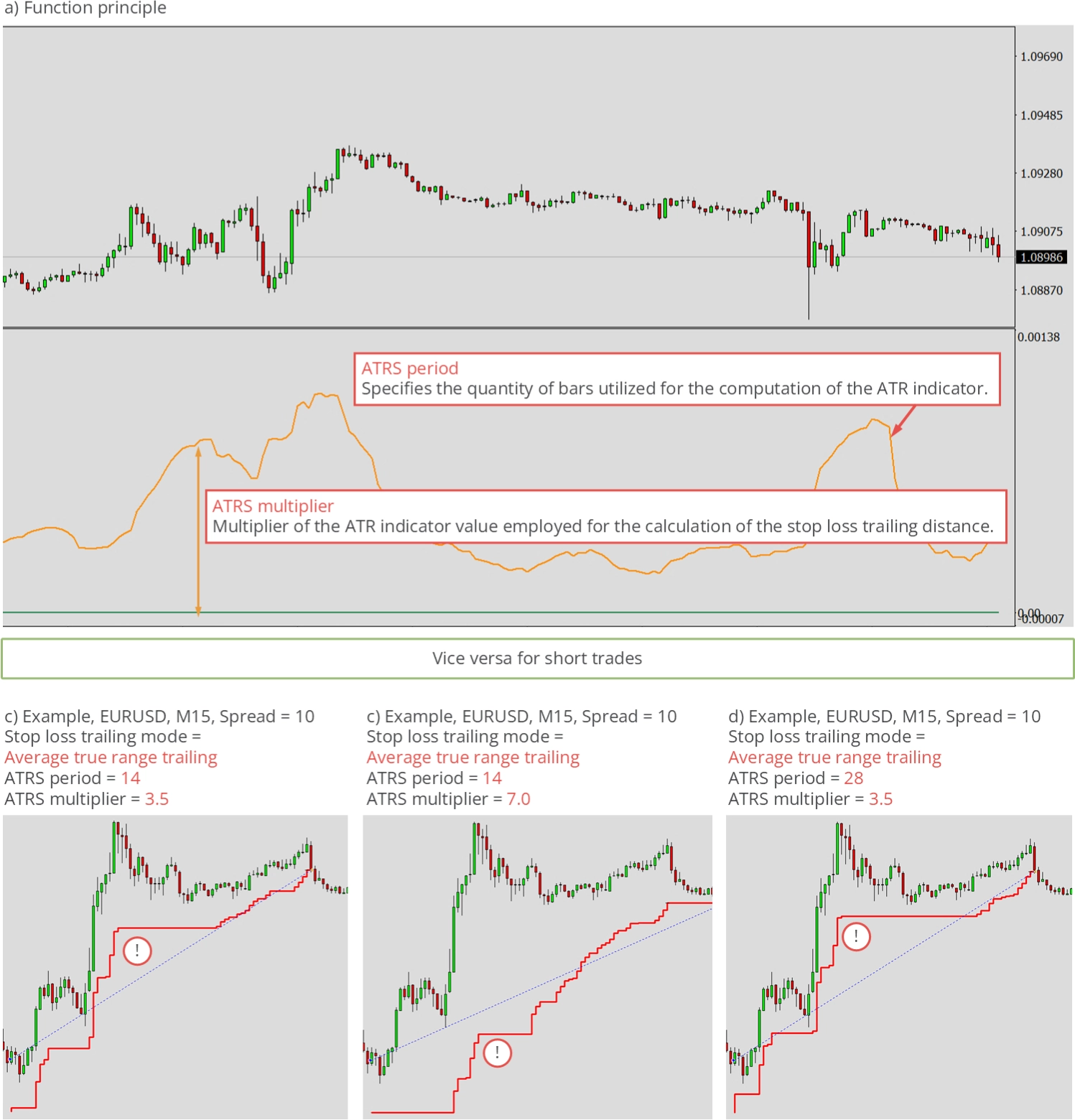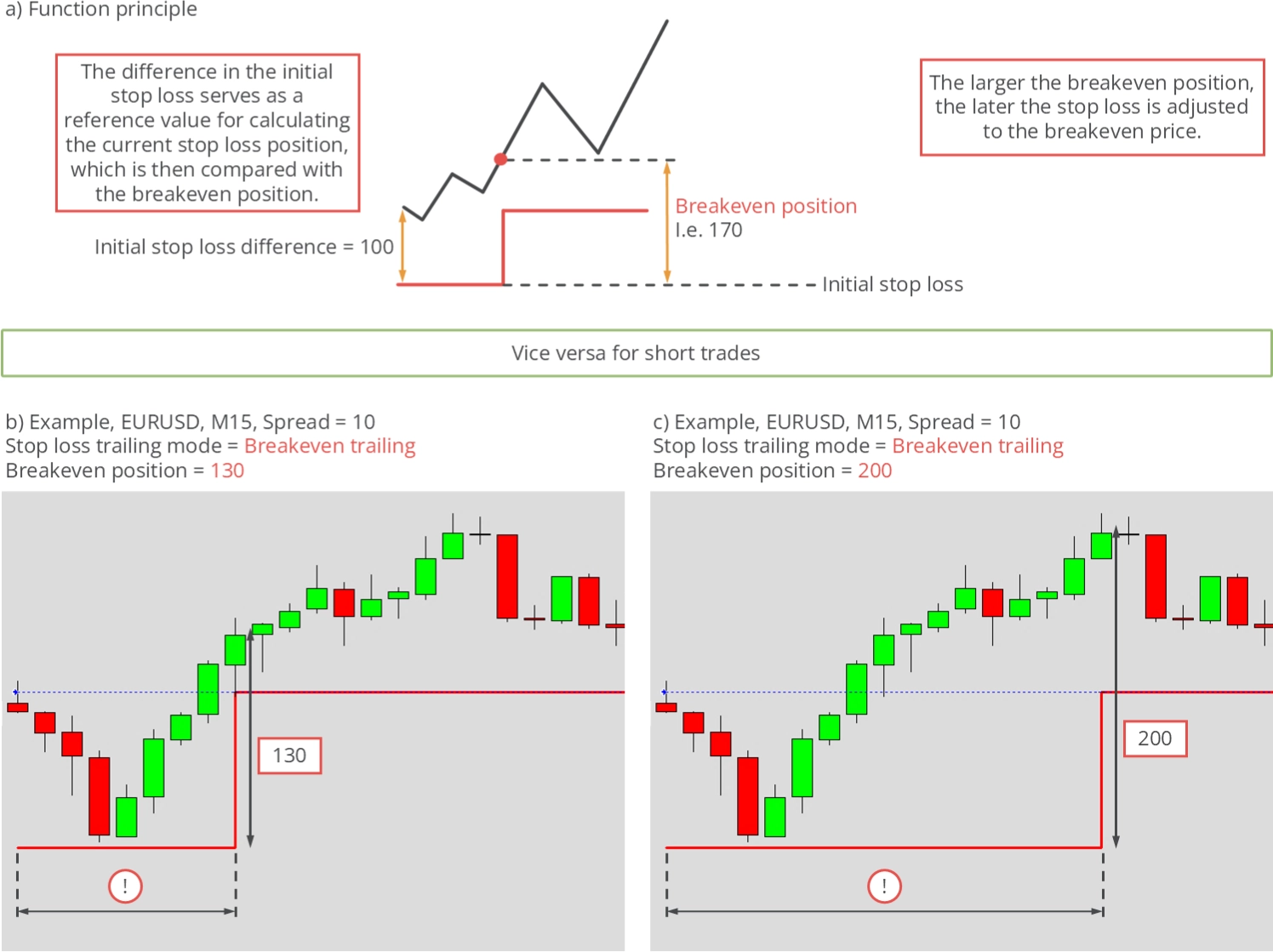Configuration
This page provides a detailed explanation of each input parameter, enabling you to configure the Stop Loss Manager to suit your needs. While the default input parameters offer a universally applicable configuration, tailoring the Stop Loss Manager to the specific symbol and timeframe you're working with is recommended. This might seem daunting initially for beginners, but rest assured, the default parameters are a great starting point. Professional and advanced traders will likely need different input settings for other symbols and timeframes.
To optimize the input parameters, consider using the tester mode. Refer to the related article to familiarize yourself with this feature of the Stop Loss Manager.
Selected trailing mode
The Stop loss trailing mode input parameter allows you to switch between the five available trailing modes. Please note that the trailing method of an active Stop Loss Manager cannot be changed mid-operation. To do so, the Stop Loss Manager must be restarted and reconfigured.
| Input variable within MetaTrader (Identifier in SET file) | Default value | Comment |
|---|---|---|
| Stop loss trailing mode (IN_enmTrailingMode) | Average true range trailing | Numeric values usable in SET files: 0 - Market trailing 1 - Average true range trailing 2 - Parabolic SAR trailing 3 - Fix distance trailing 4 - Breakeven trailing |
Parameters for market trailing
Market trailing doesn't rely on complex algorithms. Instead, it uses the open and close prices of the previous candle sticks, combined with the spread, to calculate its movements. The only adjustable variable is a buffer added to the stop loss distance. This buffer can be calculated by two parameters: a fixed value measured in pips (Market buffer fix) or/and a dynamic value based on the current spread (Market buffer fix).
| Input variable within MetaTrader (Identifier in SET file) | Default value | Comment |
|---|---|---|
| Market buffer fix (IN_dMarketBufferFix) | 10.0 | This parameter introduces a buffer to the stop loss level, calculated based on a fixed number of pips. The input value cannot be smaller or equal to 0. |
| Market buffer fix (IN_dMarketBufferSpread) | 4.0 | This parameter introduces a buffer to the stop loss level, calculated based on a fixed number of pips. However, in this case, the parameter multiplies the current spread value. The product of this multiplication determines the buffer level. The input value cannot be smaller or equal to 0. |
Based on the spread, the dynamic option is handy to avoid being stopped during night hours. For instance, the ask price is crucial for long trades to define when a trade will close. However, the stop loss level might come too close if the spread is too large. Therefore, during phases of large spread, the market trailing variant can automatically adapt the buffer to better react in volatile phases or during night hours.
The effect of the input parameter can be observed in the chart below.

As can be seen, both parameters move the stop loss line further away from the actual price. Both buffer types can be combined freely. If used together, their values will be added to each other.
Parameters for average true range trailing
The average true range (ATR) trailing method employs an ATR indicator to calculate the stop loss distance. This widely used indicator is a standard tool for assessing a price chart's volatility.
| Input variable within MetaTrader (Identifier in SET file) | Default value | Comment |
|---|---|---|
| ATRS period (IN_nAtrsPeriod) | 14 | The input value cannot be smaller or equal to 0. |
| ATRS multiplier (IN_dAtrsMultiplier) | 3.5 | The input value cannot be smaller or equal to 0. |
The parameters for configuring the ATR trailing method include the ATRS period, the period used to calculate the ATR indicator, and the ATRS multiplier. The raw ATR value is typically too small to be used as a trailing stop loss distance, so it's common to multiply the raw indicator value with a multiplier. A frequently used value for the multiplier is 3.5.

By adjusting these values, the ATR trailing method can respond more to the current price.
Parameters for parabolic SAR trailing
Parabolic SAR (PSAR) trailing stop losses utilize a PSAR indicator, another standard tool in modern trading. This indicator usually comes with two input parameters.| Input variable within MetaTrader (Identifier in SET file) | Default value | Comment |
|---|---|---|
| PSAR step (IN_dPsarStep) | 0.02 | The input value cannot be smaller or equal to 0. |
| PSAR maximum (IN_dPsarMaximum) | 0.2 | The input value cannot be smaller or equal to 0. |
The PSAR value is directly taken as the stop loss, depending on whether the current PSAR value qualifies. Since the PSAR is drawn above or below the price chart, there are phases when the PSAR does not output valid values for stop losses. This typically happens when a trade is opened. When the PSAR changes its characteristic, the stop loss may move quickly close to the price. The input parameters PSAR step and PSAR maximum are used to adapt this movement.

The lower these values are, the more gently the stop loss moves towards the price value.
Parameters for breakeven trailing
The breakeven trailing method implies that the stop loss value is only modified once at a specific price. This ensures that already-made profits are secured. The sudden jump in stop loss will occur when the trade is already in a respectable profitable zone, and it's not expected that the trade will change its direction.
| Input variable within MetaTrader (Identifier in SET file) | Default value | Comment |
|---|---|---|
| Breakeven position (IN_nBreakevenPosition) | 150 | The input value cannot be smaller or equal to 0. |
You can use the Breakeven position input parameter to define the moment when the jump will occur. The initial distance between the opening price and initial stop loss represents the reference value 100. Let's assume this was 80 pips. If the Breakeven position is set to 150, the jump to breakeven will occur when the price rises 40 pips above the opening price. As seen in the illustration below, the larger the breakeven position, the later the jump.

This trailing method should only be used with a take profit or by manual supervision and closing the trade. Since the stop loss value never changes again, the maximum outcome will be zero profit. Fees such as commission or swap are not included in the calculation of the breakeven price.